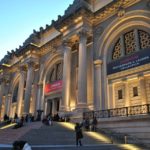One of the world’s greatest repositories for human knowledge regarding the natural sciences, the venerable American Museum of Natural History has been one of New York City’s premier cultural institutions since 1869. Since its establishment almost 150 years ago, the museum has come a long way towards advancing knowledge about natural history and science in the United States – not to mention serving as one of the best field trip destinations for school students! Despite its fame, few people know it’s fascinating history. With the museum set to undergo a multimillion dollar renovation and expansion in anticipation of its 150th birthday, there’s never been a better time to explore the hidden history of American Museum of Natural History!
The museum’s impetus was provided by scientists Dr. Albert S. Bickmore and Louis Agassiz, who enlisted the aid of prominent business and civic leaders as well as wealthy philanthropists such as Theodore Roosevelt, Sr. in their push for a new museum dedicated to the natural sciences in New York City. Their campaign eventually won the support of city and state politicians such as Governor John Thompson Hoffman, who signed into law a bill officially establishing the museum in April 1869. Initially based in the Arsenal building in Central Park, the museum’s founders quickly realized a new, dedicated building was needed to house the ambitious museum.
The cornerstone of the current American Museum of Natural History was laid in 1874 across the street from Central Park. The museum’s new building, designed by architect J. Wrey Mould, opened in 1877 in the fashionable Victorian Gothic style. The museum added many new additions over the years, including a grand Beaux-Arts entrance facing Central Park West in 1936. A new master plan was created for the library in the 1990s and a new library added in 1992. In anticipation of its 150th birthday, the museum has undertaken even more new expansions and renovations in recent years, with plans for the new expansions called the Richard Gelder Center for Science, Education and Innovation being revealed in late 2015. As a testament to the museum’s cultural, educational and historical importance, the museum was designated as an official New York City Landmark in 1967 and later added to the U.S. National Register of Historic Places in 1976.
For nearly 150 years, the American Museum of Natural History has helped to enlighten New Yorkers and visitors alike about the natural sciences. With its 150th anniversary approaching and new expansion and renovation plans in the works, the museum’s next chapter may be its most important yet.
Photo Credit: Public Domain via Pixabay






